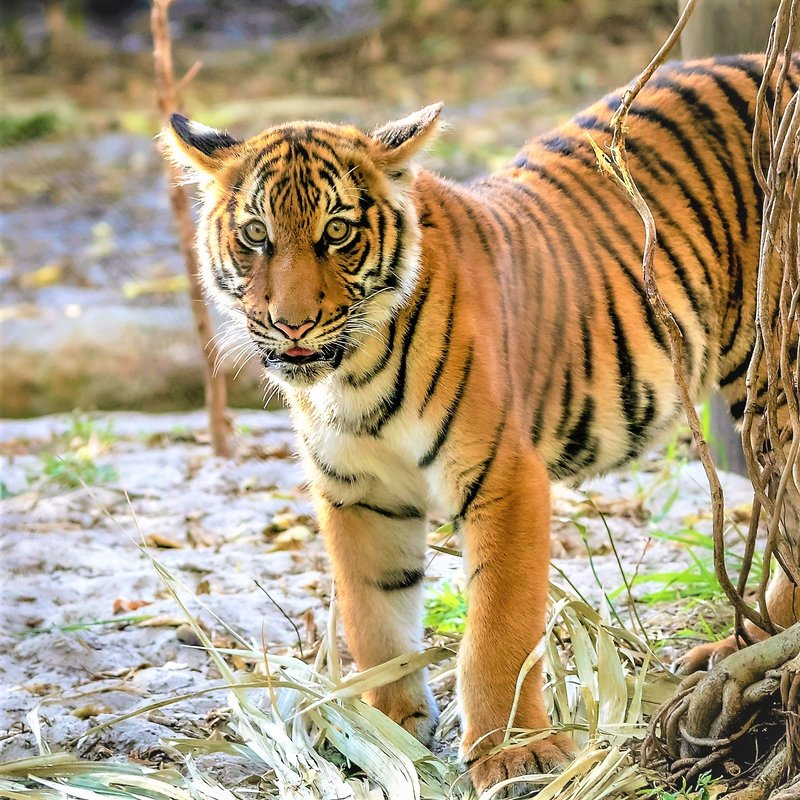
The Malayan tiger is a subspecies that roams primarily in the dense forests of Peninsular Malaysia. With their striking orange coats and bold black stripes, they embody the wild beauty of their habitat. However, living in proximity to any large predator raises valid concerns about safety. So, how often do these tigers actually pose a threat to people? Are the stories of attacks just exaggerations, or is there some truth behind them? Let’s take a closer look.
Understanding the Malayan Tiger
The Malayan tiger (*Panthera tigris jacksoni*) is one of the smaller subspecies of tiger, but don’t let their size fool you. They are powerful hunters, adapted to thrive in the dense jungles where they live. These tigers are primarily solitary, often hunting at night. Their diet mainly consists of deer, wild boar, and smaller mammals. This natural instinct as apex predators is what shapes their behavior towards humans.
Interestingly, the Malayan tiger is also critically endangered, with estimates suggesting fewer than 250 individuals left in the wild. Habitat loss due to deforestation and illegal poaching have significantly reduced their numbers. As their habitats shrink, encounters with humans become more frequent, which can lead to dangerous situations for both parties.
You might be wondering how they typically behave when in contact with humans. Generally, Malayan tigers tend to avoid interaction. They are elusive and prefer to stay hidden in their territories. However, when cornered or threatened, even the most timid creature can react unpredictably.
Are Malayan Tigers Known to Attack Humans?
While Malayan tiger attacks on humans are relatively rare, they do happen. When attacks occur, they often stem from specific situations. For instance, tigers might strike if they feel threatened, are surprised, or if they’re hungry and see humans as potential prey. In rural areas, farmers have reported losing livestock, which can lead tigers to venture closer to human settlements.
Local folklore sometimes exaggerates the dangers of these big cats, painting them as ruthless killers. However, here’s the thing: most tigers would rather avoid humans altogether. They’ve evolved to see humans as potentially dangerous and might only attack if they perceive a direct threat or if they’re in search of food.
There are documented cases of Malayan tigers attacking humans, but they typically involve individuals engaging in activities near the tiger’s territory or when tigers are provoked. It’s essential to respect their space and understand that they are wild animals with instincts that often conflict with human activity.
What Factors Contribute to Malayan Tiger Attacks?
Several factors can lead to Malayan tiger attacks, and understanding these can help mitigate risks. Here are a few key contributors:
- Habitat Loss: As forests are cleared for agriculture or development, tigers are forced into smaller areas, increasing encounters with humans.
- Food Scarcity: When natural prey becomes scarce, tigers might turn to livestock as an alternative food source, leading them closer to human settlements.
- Human Provocation: Approaching a tiger or startling it can trigger defensive behavior. It’s crucial to maintain a safe distance and avoid surprising these big cats.
By being aware of these factors, we can take steps to minimize risks. Educating local communities about the presence of tigers and their behaviors can foster coexistence rather than conflict.
How to Stay Safe in Malayan Tiger Territory
If you’re venturing into areas where Malayan tigers roam, here are some tips to keep in mind to reduce the risk of a dangerous encounter:
- Stay on Established Trails: Stick to marked paths to avoid wandering into tiger territories.
- Travel in Groups: Tigers are less likely to approach larger groups of people, so it’s safer to explore with others.
- Avoid Nighttime Activities: Since tigers are nocturnal, doing activities during the day can minimize risks.
- Be Aware of Your Surroundings: Keep an eye out for warning signs of tiger presence, like tracks or recent kills.
While these tips can help, remember that there’s no guarantee of safety in wildlife encounters. Always respect the environment and its inhabitants.
The Role of Conservation Efforts
Protecting the Malayan tiger is crucial, not just for their survival, but also for the safety of human communities living nearby. Conservation organizations are working hard to preserve their habitats and reduce human-wildlife conflict. This includes creating wildlife corridors that allow tigers to roam safely between isolated patches of forest and offering compensation to farmers who suffer livestock losses due to tiger predation.
Additionally, educating local communities about the importance of tigers in the ecosystem can help foster a positive attitude toward these majestic creatures. When people understand the ecological benefits tigers provide—like keeping prey populations in check—they may be more inclined to support conservation efforts.
You might find it encouraging to know that, in many regions, awareness and education have led to more peaceful interactions between humans and tigers. Building a connection with the local ecosystem can benefit both parties.
When it comes down to it, the Malayan tiger can pose a danger to humans, but it’s essential to put that risk into perspective. These incredible animals are more at risk from us than we are from them. By understanding their behavior, respecting their habitats, and supporting conservation efforts, we can coexist with these magnificent creatures.
Embracing a mindset of respect can go a long way in ensuring that both humans and tigers thrive. Just like the wild landscapes they inhabit, there’s so much to learn from these big cats. They remind us of the beauty and unpredictability of nature—and that in respecting it, we can find harmony rather than fear. So next time you think of the Malayan tiger, remember that while they are predators, they also play an essential role in their ecosystem, just like we do in ours.

